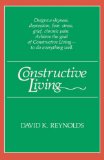Constructive Living by David Reynolds
 Constructive Living by David Reynolds
Constructive Living by David ReynoldsI picked up a used copy (the book is out of print) of Constructive Living by David Reynolds after reading a comment from James Hogan on Patri Friedman's livejournal.
The book bills itself on the cover: "Outgrow shyness, depression, fear, stress, grief, chronic pain. Achieve the goal of Constructive Living—to do everything well.
At around 100 pages in length, the book is a quick read that essentially admonishes you to act your way into a better life. In keeping with my fascination/recent obsession with doing over thinking as well as Glasser's Control Theory and Gilbert's Stumbling on Happiness, CL was right up my alley.
Part of CL is about paying attention to your life. To some extent, it seems a bit like a "living in the moment" sort of mantra; however, I think the idea is much more poignant/specific than that. If I could sum up CL in one sentence, I'd clumsily suggest that constructive living is "Acknowledging your feelings and then taking control of what you are doing."
It's in the doing that you can outgrow your feelings. There's a maxim somewhere in the book that has managed to stick in my brain:
"Doing wags the tail of feelings."
To elaborate somewhat on this quote, we can't control our feelings. And since I can't control what I'm feeling, I also can't control the feelings of those I care about. What I can do is control my behavior. I can do something—anything. By doing, I can change my situation, which will almost always ultimately change my feelings.
We are only what we do. So doing is not just about taking control, it's also a rejection of wishing, wanting, can'ting, or any other type of behavior that is non-constructive. I can dream about wanting to be successful all day — those dreams may be fun to imagine, but they do nothing to advance my state.
Here's a memorable quote from the book that somewhat deals with the idea of dreaming and doing:
now
Indeed!
Constructive Living includes a number of exercises at the end of the book that work to refocus your life on doing. Not surprisingly, one of the exercises is exercising. Exercising is a fundamental way to act in a positive way and can work to change your feelings. Incidentally, he also suggests preparing your own meals. It's interesting (to me) that over the past couple years, amidst a number of things I could not control, two things I've returned to over and over again have been cooking and exercise, which are really two core things that make you feel like a competent and capable human being.
CL has a distinct buddhist undertone. Another maxim in the book is that "self-centeredness is suffering," which is less about being selfish and more about focusing your attention outward instead of dwelling on your own feelings. CL is actually based on Morita Therapy, a treatment that emerged out of Japan.
For such a short book, CL is worth re-reading. Even in its simplicity it has a great deal to digest, and I'm pretty sure I missed a few things.
Coincidentally, Penelope Trunk blogged on How to have more Self-Discipline the other day, and I'd recommend her post for a complimentary expression of Constructive Living (though I have no reason to believe that Penelope Trunk has read this book, there is a lot of great overlap in her post, which is also much better written than this scribbled out book review!).
